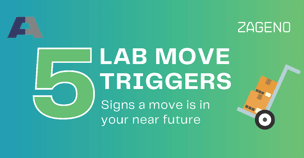R&D procurement might seem straightforward, but behind the scenes, small mistakes can cause big headaches for labs. Mismanaged orders, unexpected product delays, and budget overruns can derail even the best-laid research plans.
The good news? With a little insight and a few process tweaks, many common pitfalls are easy to avoid. Let’s take a look at the top lab procurement mistakes and how you can sidestep them to keep your research moving forward without disruption.
Common lab procurement mistakes (and how to fix them)
|
Mistake
|
Quick Fix
|
Pro Tip
|
|---|---|---|
|
🔒 Relying on a small supplier group |
Diversify your vendor base using a lab supply marketplace |
Choose a platform that offers side-by-side comparisons and availability checks |
|
📦 Poor inventory tracking |
Implement automated inventory management tools |
Connect your inventory to your procurement system for seamless reordering |
|
💸 Focusing on price only |
Evaluate total cost of ownership (TCO), not just unit price |
Consider shipping, maintenance, and reliability in your calculations |
|
🔄 Lack of formal procurement workflows |
Standardize processes with approval workflows and preferred vendor lists |
Use procurement platforms that allow customized workflows by department |
|
🔍 Skimping on product comparisons |
Thoroughly compare specifications, pricing, and vendor reliability before buying |
Leverage multi-vendor platforms to simplify comparisons |
|
🕵️♂️ Inadequate supplier vetting |
Verify supplier certifications, customer reviews, and fulfillment history |
Prioritize vendors with ISO or GMP certifications for critical supplies |
|
✍️ Manual purchasing processes |
Automate orders and approvals with digital procurement tools |
Integrate purchasing into your lab operations platform for greater efficiency |
|
⏳ Delaying reorders |
Set minimum stock thresholds and enable low-inventory alerts |
Forecast supply needs based on project timelines to avoid emergencies |
|
🙈 No procurement ownership |
Assign clear procurement roles and responsibilities |
Make procurement tasks part of onboarding and project planning |
|
📊 Ignoring procurement data |
Track and analyze spend patterns, supplier performance, and delivery times |
Use procurement dashboards to find hidden savings and avoid bottlenecks |
1 Relying on a small supplier group
The mistake: Gravitating towards a small group of trusted suppliers may feel like the easiest path, but it leaves your lab vulnerable to stockouts, price hikes, and delivery delays.
The fix: Diversify your supply chain to increase flexibility and resilience. A lab supply marketplace like ZAGENO makes it simple to access thousands of suppliers in one centralized platform, offering real-time price comparisons and product availability without adding extra work.
Tip: Learn how a diversified sourcing strategy supports supply chain resilience according to McKinsey. Check out how ZAGENO’s smart lab procurement platform simplifies sourcing across all your categories.
2 Poor inventory visibility
The mistake: Without clear, centralized inventory tracking, labs often double-order supplies they already have or, worse, realize too late they are out of critical materials.
The fix: Move away from paper logs and spreadsheets. Integrate an automated inventory management system that syncs with procurement workflows.
Tip: Explore our guide on how to properly store and maintain lab supplies to reduce costs.
3 Focusing on price only
The mistake: Opting for the cheapest supplier without considering quality, shipping times, or service can result in unreliable deliveries and wasted spend.
The fix: Balance cost against reliability and service. Always review the total cost of ownership. For a deeper dive, the National Institute of Governmental Purchasing explains why TCO is a better long-term strategy than simply choosing the lowest bidder.
Tip: Read more about smart buying strategies on finding the best overall value in scientific equipment vendors.
4 Unclear internal procurement workflows
The mistake: Without a clear procurement workflow, labs often face fragmented ordering that drives up longtail expenses, complicates budget tracking, and makes it harder to negotiate better pricing or maintain strong supplier partnerships.
The fix: Establish a clear, standardized procurement workflow with approval stages, preferred vendor lists, and spend controls. Tools like ZAGENO allow teams to customize workflows that are easy to follow without slowing down scientific work.
Tip: Learn how procurement workflow automation improves efficiency in the Chartered Institute of Procurement & Supply’s guide.
5 Skimping on product comparisons
The mistake: Defaulting to the same brand, model, or supplier "because it worked before" can mean missing out on innovations, cost savings, or better specs.
The fix: Use metasearch features to compare multiple suppliers, prices, and technical details side by side.
Tip: Discover why scientific lab supply choices directly impact experiment accuracy.
6 Inadequate supplier vetting
The mistake: Choosing a vendor without checking delivery history, certifications, or customer service reputation can result in major supply chain headaches.
The fix: Perform basic due diligence: look at customer reviews, request fulfillment metrics, and check for ISO or GMP certifications where applicable.
Tip: Working with a vetted supplier network, like the one curated inside ZAGENO’s platform, helps you source with confidence.
7 Sticking with manual purchasing
The mistake: Spreadsheets, email threads, and paper forms may have worked ten years ago, but they slow down modern procurement and leave room for error.
The fix: Automate where you can. Integrating a digital R&D procurement platform provides transparency, tracking, and speed.
Tip: Get inspired by how a biotech company achieved 91% procurement automation with ZAGENO.
8 Delaying critical reorders
The mistake: Waiting until inventory is dangerously low often leads to rush orders, higher shipping costs, and sometimes, project delays.
The fix: Set reorder thresholds for critical supplies and automate restock alerts.
Tip: Explore inventory management strategies for research labs.
9 No single point of procurement responsibility
The mistake: When procurement is everyone's job, it often becomes no one's priority.
The fix: Assign clear ownership of procurement tasks. Even in decentralized research environments, a designated procurement coordinator ensures oversight and accountability.
Tip: Learn how Sanofi optimized lab supply procurement using ZAGENO.
10 Neglecting procurement data and insights
The mistake: Without visibility into historical purchasing data, it's hard to identify trends, spot savings opportunities, or optimize vendor relationships.
The fix: Leverage reporting tools that consolidate purchasing data into actionable insights. ZAGENO’s platform, for instance, offers real-time spend analytics so you can forecast needs and negotiate better deals.
Tip: Explore how analyzing procurement data can drive smarter decisions in this insight from McKinsey.

Smarter procurement starts here
The fastest way to fix procurement mistakes is to recognize where your lab might be vulnerable and put simple, scalable solutions in place. Better procurement practices mean more reliable experiments, fewer supply delays, and stronger research outcomes.
Ready to strengthen your lab’s procurement process? Talk to ZAGENO today and discover how a smarter platform makes all the difference.







